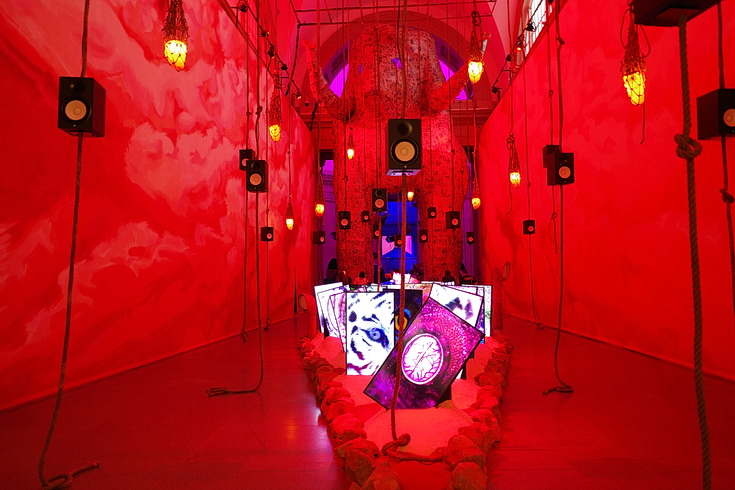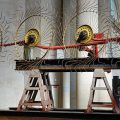
I’ll be honest – I haven’t got the foggiest idea what Heather Phillipson’s installation at the Tate Britain is all about, but I can say one thing: it is bloody brilliant.
After endless months in miserable lockdown, the audio visual onslaught of this eye-popping installation brought a smile to my face and it stayed there for the engrossing half hour I spent exploring the individua elements.
Rupture No 1: Blowtorching the Bitten Peach – to give it its full title – is a pleasing mix of industrial parts, papier mâché, aircraft parts, fuel tankers, anchors and tin foil. It is a heap of fun.
The Tate Britain website does its best to explain what’s going on:
In her words, she is proposing the spaces as a sequence of ‘charged ecosystems, maladaptive seasons and unearthed lifeforms’.
She reimagines the galleries as alive, and happening in a parallel time-zone. Mutant creatures, built from technological remains, populate the space.
Described by Phillipson as a ‘pre-post-historic environment’, the work and its title evoke an abundance of sensations and associations that resist coherence. The artist says she is attempting to ‘cultivate strangeness, and its potential to generate ecstatic experience’.
Phillipson’s work often involves collisions of wildly different imagery, materials and media.
Through multiple, unexpected combinations, she conjures absurd and complex systems. Here, salvaged machines, colossal papier-mâché sculptures and hand-painted scenes are layered with digital video and sound.
Mountains of salt, bisected aircraft fuel tanks, mobile gas canisters, rotating anchors and shapeshifting roof vents are doused with tinted light. Everything is remixed and redeployed.
Phillipson’s multimedia projects include video, sculpture, installation, music, poetry and digital media. She describes her works as ‘quantum thought experiments’.
They often carry an underlying sense of threat – a suggestion that, in the artist’s words, ‘received ideas, images and the systems that underpin them may be on the verge of collapse’.
The exhibition is free to visit (pre-booking required) and runs until the 23rd January 2022. I thoroughly recommend it.
More info
Tate Britain
Millbank, Westminster
London SW1P 4RG
OPENING TIMES
Monday to Sunday 10.00–18.00
Join the discussion
- Tate Britain – art, performance, events (65 posts)
- London art exhibitions, installations and events – photos and chat


